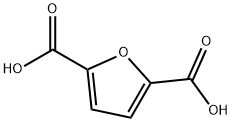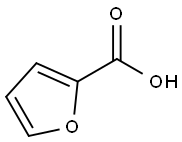
2,5-Furandicarboxylic acid synthesis
- Product Name:2,5-Furandicarboxylic acid
- CAS Number:3238-40-2
- Molecular formula:C6H4O5
- Molecular Weight:156.09
Chapter 5 - Advances in the synthesis and application of 2,5-furandicarboxylic acid

67-47-0
602 suppliers
$5.00/100mg

3238-40-2
471 suppliers
$6.00/1g
Yield:3238-40-2 100%
Reaction Conditions:
with sodium carbonate at 80 - 120; under 30003 Torr; for 4 h;Temperature;Reagent/catalyst;
Steps:
Experimental Conditions
Experimental Conditions
The HMF having 95% purity was supplied by Interchim.
The method of the invention was implemented in a discontinuous reactor under pressure in a 300 mL autoclave equipped with magnetically driven gas-inducing agitator. Heating was ensured by a heating collar connected to a PID controller (proportional integral derivative). A sampling gate allowed the taking of a sample from the reaction medium via an immersed tube, allowing the monitoring of the progress of the reaction over time. The samples were analysed by HPLC chromatography with two RID detectors (Refractive Index Detector) and PDA (Photodiode array) (ICE-Coragel 107H column, eluting with 10 mM H2SO4). Total Organic Carbon (TOC) in solution was also analysed using a TOC analyser and the value measured was compared with the mass balance (MB) calculated by HPLC.
The reactor was charged with 150 mL of 100 mM aqueous HMF solution (2 g), a weight of catalyst corresponding to a HMF/Pt molar ratio of 100, and the desired amount of base in the form of NaOH (comparative example), NaHCO3, KHCO3, Na2CO3 or K2CO3 expressed as base/HMF molar ratio. Air was added at a pressure of 40 bar and the reactor heated to 100° C.
The method such as described above was implemented with the 5.1% Pt-1% Bi/C(3SW) catalyst (Bi/Pt=0.2), with Na2CO3/HMF molar ratio=2 and at a temperature of between 80 and 120° C.
The results are grouped together in Tables 23 to 25 below
References:
US2015/376154,2015,A1 Location in patent:Paragraph 0051; 0052; 0053; 0054; 0079; 0080

1623-88-7
88 suppliers
$60.00/25mg

3238-40-2
471 suppliers
$6.00/1g

88-14-2
505 suppliers
$5.00/10g

3238-40-2
471 suppliers
$6.00/1g

